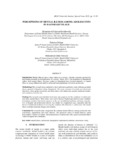| dc.contributor.advisor | | |
| dc.contributor.author | Noykhovich, Ekaterinovla Yakevna | |
| dc.contributor.author | Bulage, Patience | |
| dc.contributor.author | Hossain, Mohammad Didar | |
| dc.date.accessioned | 2016-04-20T16:13:27Z | |
| dc.date.available | 2016-04-20T16:13:27Z | |
| dc.date.copyright | 2012 | |
| dc.date.issued | 2012-12 | |
| dc.identifier.citation | Noykhovich, Ekaterinovla Yakevna, Bulage, Patience & Hossain, Mohammad Didar (2012). Perceptions of mental illness among adolescents in Bagnibari vilage. BRAC University Journal, Special Issue, 11–20. | en_US |
| dc.identifier.issn | 1811-3079 | |
| dc.identifier.uri | http://hdl.handle.net/10361/5176 | |
| dc.description | Includes bibliographical references (page 19-20). | en_US |
| dc.description.abstract | Introduction: Mental illnesses have a large impact on a society, affecting economic productivity and bearing potential for destabilization of a society. About 16% of the population in Bangladesh suffers from mental illness. Previous studies in Bangladesh have focused primarily on mental illness in young children and adults in urban and rural populations, but not on adolescents.
Methodology:The research team conducted a short exploratory qualitative study utilizing grounded theory approach in Bagnibari village, Bangladesh. The study consisted of in-depth and semi-formal interviews, focus group discussions, and observations with adolescents, parents, traditional healers, and caretakers of adolescents.
Findings:The research team identified local terms and symptoms for the conditions of adolescents who had a mental illness. These terms were used to find an English equivalent for each condition. Community members had mixed responses to the use of traditional medicine and home remedies. Use of hospital and professional doctors was similar for complicated cases, especially after the failure of traditional medicine in relieving the condition. The behaviors of adolescents with mental illness included emotional changes and isolation.
Conclusion:The research teams categorized the common mental illnesses among adolescents into convulsions, supernatural, and worry illnesses. The perceived causes of mental illnesses varied from mother’s fault to evil spirits. Social interactions of adolescents with a perceived mental illness varied throughout the community. | en_US |
| dc.description.statementofresponsibility | Ekaterinovla Yakevna Noykhovich | |
| dc.description.statementofresponsibility | Patience Bulage | |
| dc.description.statementofresponsibility | Mohammad Didar Hossain | |
| dc.format.extent | 10 pages | |
| dc.language.iso | en | en_US |
| dc.publisher | BRAC University | en_US |
| dc.rights | BRAC University Journals are protected by copyright. They may be viewed from this source for any purpose, but reproduction or distribution in any format is prohibited without written permission. | |
| dc.subject | Mental illness | en_US |
| dc.subject | Adolescents | en_US |
| dc.subject | Supernatural condition | en_US |
| dc.title | Perceptions of mental illness among adolescents in Bagnibari village | en_US |
| dc.type | Article | en_US |
| dc.contributor.department | James P Grant School of Public Health, BRAC University | |

